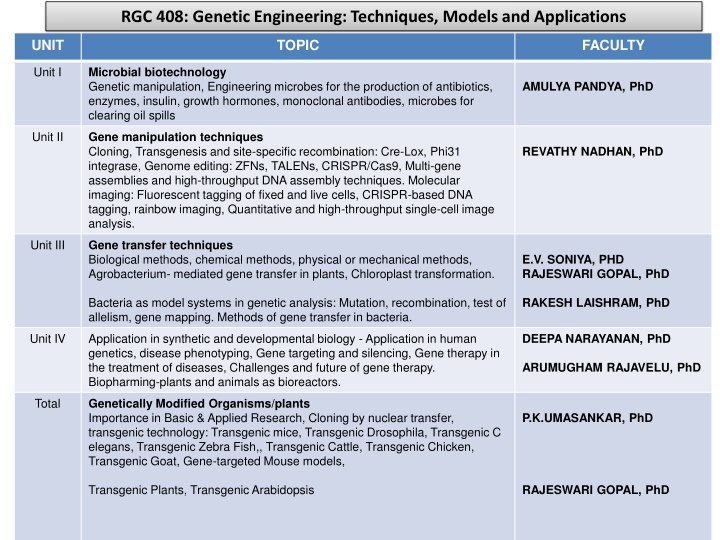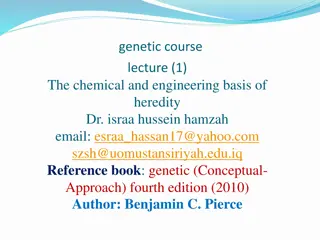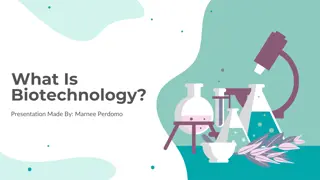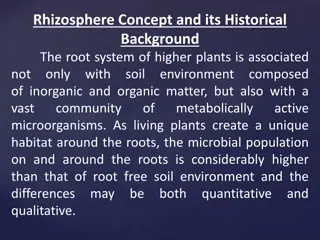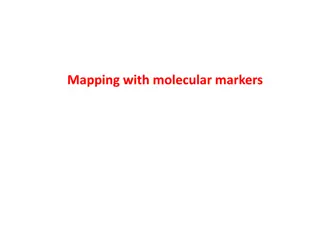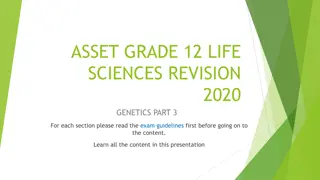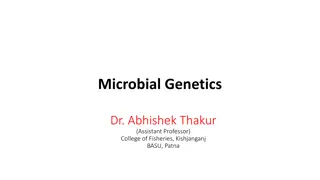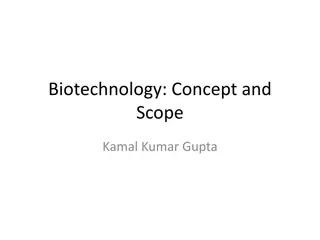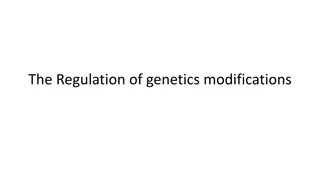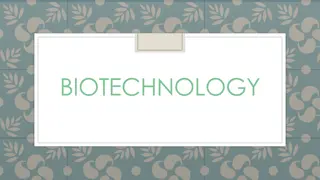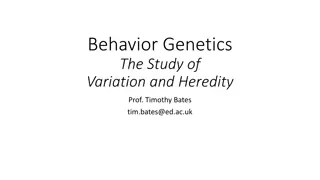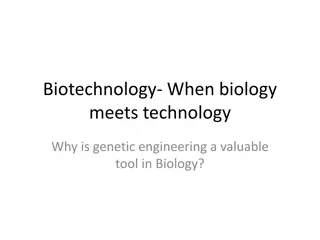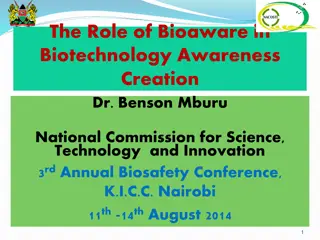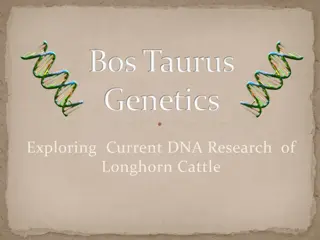Genetic Engineering: Techniques, Models, and Applications in Microbial Biotechnology and Plant Genetics
This document explores genetic manipulation, gene manipulation techniques, gene transfer techniques, applications in synthetic and developmental biology, genetically modified organisms/plants, plant tissue culture, micropropagation of plants, genetics in evolution, and genetics in crop improvement methods. It covers a wide range of topics related to genetic engineering and its applications in various fields.
Download Presentation

Please find below an Image/Link to download the presentation.
The content on the website is provided AS IS for your information and personal use only. It may not be sold, licensed, or shared on other websites without obtaining consent from the author.If you encounter any issues during the download, it is possible that the publisher has removed the file from their server.
You are allowed to download the files provided on this website for personal or commercial use, subject to the condition that they are used lawfully. All files are the property of their respective owners.
The content on the website is provided AS IS for your information and personal use only. It may not be sold, licensed, or shared on other websites without obtaining consent from the author.
E N D
Presentation Transcript
RGC 408: Genetic Engineering: Techniques, Models and Applications UNIT TOPIC FACULTY Unit I Microbial biotechnology Genetic manipulation, Engineering microbes for the production of antibiotics, enzymes, insulin, growth hormones, monoclonal antibodies, microbes for clearing oil spills AMULYA PANDYA, PhD Unit II Gene manipulation techniques Cloning, Transgenesis and site-specific recombination: Cre-Lox, Phi31 integrase, Genome editing: ZFNs, TALENs, CRISPR/Cas9, Multi-gene assemblies and high-throughput DNA assembly techniques. Molecular imaging: Fluorescent tagging of fixed and live cells, CRISPR-based DNA tagging, rainbow imaging, Quantitative and high-throughput single-cell image analysis. REVATHY NADHAN, PhD Unit III Gene transfer techniques Biological methods, chemical methods, physical or mechanical methods, Agrobacterium- mediated gene transfer in plants, Chloroplast transformation. E.V. SONIYA, PHD RAJESWARI GOPAL, PhD Bacteria as model systems in genetic analysis: Mutation, recombination, test of allelism, gene mapping. Methods of gene transfer in bacteria. RAKESH LAISHRAM, PhD Unit IV Application in synthetic and developmental biology - Application in human genetics, disease phenotyping, Gene targeting and silencing, Gene therapy in the treatment of diseases, Challenges and future of gene therapy. Biopharming-plants and animals as bioreactors. DEEPA NARAYANAN, PhD ARUMUGHAM RAJAVELU, PhD Total Genetically Modified Organisms/plants Importance in Basic & Applied Research, Cloning by nuclear transfer, transgenic technology: Transgenic mice, Transgenic Drosophila, Transgenic C elegans, Transgenic Zebra Fish,, Transgenic Cattle, Transgenic Chicken, Transgenic Goat, Gene-targeted Mouse models, P.K.UMASANKAR, PhD Transgenic Plants, Transgenic Arabidopsis RAJESWARI GOPAL, PhD
RGC 409: Plant Genetic Engineering UNIT TOPIC FACULTY Unit I Plant tissue culture Scope, Importance and limitations of plant tissue culture; Tissue culture media - composition and preparation E.V. SONIYA, PHD RAJESWARI GOPAL, PhD R.S.LAKSHMI, PhD Unit II Micro propagation of plants Initiation and maintenance of callus and suspension cultures; in vitro genetic conservation; in vitro clonal multiplication; Plant growth regulators for organogenesis, somaclonal variation and cell line selection, production of haploids and homozygous cell lines. Selection and maintenance of cell lines, cryopreservation, germplasm collection and conservation R.S LAKSHMI, PhD Unit III Genetics in evolution Origins of Agriculture, Evolution and distribution of species and forms - wild relatives and germplasm; Genetics cytogenetics and genome relationship, Centers of origin and biodiversity hot spots; Crop domestication: domestication syndrome, monophyletic and polyphyletic domestication with examples. Twenty-first Century Plant Domestication. Gene bank management: Gene conversion, Gene duplication and divergent evolution, collecting, maintenance, evaluation, storage and documentation Genetic diversity within crops, Tools for drawing phylogenetic inferences and its importance. R.S LAKSHMI, PhD
RGC 410: Plant Genetic Engineering UNIT TOPIC FACULTY Unit IV Genetics in Crop improvement methods Breeding, Hybridization, backcross breeding, recombinant inbred lines, Molecular breeding- marker assisted selection (MAS), foreground and background selection, QTLs- cisQTLs, eQTLs, trait introgression, Genome wide association studies. Cytoplasmic male sterility and principles of hybrid seed production, TGMS and PGMS, applications of male sterility in hybrid seed production. Transgenic male sterility, clonal propagation, grafting and their uses, Plant tissue culture, Hormones and their uses, Double haploids development mechanisms and its application in crop improvement. Whole genome sequencing and transcriptomics uses in crop improvement. R.S LAKSHMI, PhD Unit V Biotechnological advances in crop improvement Plant transformation vectors - T-DNA and viral vectors, direct gene transfer vectors; Selectable marker and reporter genes, Plant transformation by Agrobacterium sp., non-Agrobacterium sp., and in planta transformation, Molecular mechanism of T-DNA transfer; Direct gene transfer methods in plants - Gene gun and other methods; Chloroplast transformation; Transgene analysis, silencing and targeting; Marker-free and novel selection strategies; Multigene engineering; Genetic engineering methods to improve stress tolerance. Binary vectors, overexpression, gene silencing, gene editing, plant transformation, transgenic plants few examples (Bt-cotton, Bt-brinjal). Socio-economic benefits of transgenic plants, Biosafety -ethical issues associated with GM crops. Gene knock-down by ribozymes, antisense RNA and RNA interference. Applications of plant transgenic technology: Transgenic crops for resistance against biotic and abiotic stresses; Engineering crops for male sterility and modification of flower colour, flowering, fruit ripening and senescence; GM crops for nutritional quality and quantity; RNAi-mediated crop improvement; Molecular pharming; Metabolic engineering and hairy root culture for secondary plant products; Other applications; Global status and biosafety of transgenic plants. E.V. SONIYA, PHD RAJESWARI GOPAL, PhD
RGC 410: RNAi- Biology and applications Unit Topic FACULTY Unit I Types of RNAi Discovery of RNA interference (RNAi)- a historical perspective across multiple species, RNAi in plants and fungi, RNAi in Ceanorhabdites elegans and Drosophila, RNAi in mammalian systems: PTGS, RNAi and related phenomena. Categories of small non-coding RNAs: dsRNAs, siRNAs, shRNAs, piRNAs and miRNAs, Detection of small RNAs. DEEPA NARAYANAN, PhD Unit II Mechanism of RNAi Different components of RNAi pathway and their evolutionary conservation and role in gene silencing, RNAi-like pathway in bacteria, Molecular basis of RNAi /siRNA /miRNA mediated gene silencing, Enzymes involved in RNAi including Dicer, RISC, RNA helicase, RNA dependent RNA polymerase. RNAi in defense and the regulation of chromatin structure and gene expression; RNAi suppressors. KRISHNA KRUTHKOTI, PhD Unit III Large-scale analysis by RNAi Large-scale genetic analysis using RNAi: Genome-wide RNAi screens in mouse and human genomes to identify new transcriptional module, gene discovery related disease like cancer, building mammalian signaling pathways, High-throughput small RNA profiling, RNAi microarrays. SHIJULAL N. SATHI, PhD Unit IV miRNAs and siRNAs Pathways, expression and functions of microRNAs, High-throughput analysis of miRNA gene expression including analysis using sensitive probes; siRNA vectors-their composition, selectable markers, use of RNA PolIII promoter; siRNA delivery in vitro and in vivo like plasmid injection, tail vein injection and liposome formulation, the techniques in creating knockout mice using transgenic siRNA, Advantages of transgenic siRNA over conventional knockout technology; RNA informatics - Computational tools for miRNA discovery, Regulatory RNAs, RNA processing, RNA sequence and structure, RNA complexes, Translational control and RNA biology and disease, siRNA and miRNA design PARTHO SAROTHI RAY, PhD Unit V Double stranded RNA and its applications Expression of dsRNA in animals and plants, and its applications: RNAi vectors and generation of transgenic animals and plants, Analysis of expression of dsRNA and gene silencing; The use of RNAi in the prevention of diseases in animal models and crop improvement; RNAi therapy; Future prospects of RNAi in biology, medicine and agriculture. KB HARIKUMAR, PhD
RGC 411: Genetic engineering in animals Unit Topic FACULTY Stem Cell and Developmental Disorders Unit I Genetic engineering in creation of transgenic animals Functional genomics and animal models in human disease: cDNA/gene cloning; site-directed mutagenesis; mammalian tissue culture; cell line transfections; functional assays; Use of model organisms, methods for generation of transgenic animals/ knock-in, knock- out models (microinjection, ES cell transformation); ENumutagenesis; RNAi approach, In vitro gamete maturation. In vitro fertilization (IVF) and embryo transfer (ET), Sex determination or sex specific makers, sexing of sperm and embryos, Assisted reproductive technology (ART). Somatic cloning of animals. Improvements of animal production and quality using transgenic approach with specific examples. P.K. UMASANKAR, PhD DEBASREE DUTTA, PhD Unit II Gene Transfer methods in Animals Gene cloning vectors, Techniques for genetic engineering, Gene cloning, Gene transfer and expression of induced genes, Microinjection, Embryonic-stem cells Transfer, Retro-virus and Gene transfer, Xenografting ANI V DAS, PhD JACKSON JAMES, PhD Unit III Biosafety in genetic engineering Value of Transgenic Animals, Biosafety measures in Transgenic Animal Research, Compliance with NIH Guidelines, Policies & Protocols, Disposal of Transgenic Animals, Transfer of Recombinant DNA and Transgenic Materials. KB HARIKUMAR, PhD Unit IV Bioethics in genetic engineering Patenting Genetically Engineered Animals -Trends in Biotechnology Patenting, Biotech Patent Processing, Pharmaceutical Biotech Patents, Genetic Engineering Patents, PTO Analysis, Patent protection of living organisms, Gene technology laws in other countries ABITHA THOMAS, PhD Unit V Pharmaceutical products of DNA technology Human protein replacements, Human therapies, Vaccines KB HARIKUMAR, PhD E SREEKUMAR, PhD
